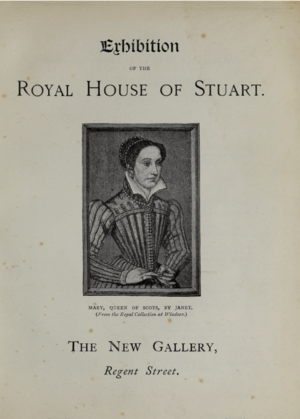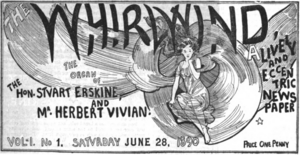Neo-Jacobite Revival facts for kids
The Neo-Jacobite Revival was a political movement in the United Kingdom about 25 years before the First World War. This group wanted to bring back a king or queen from the old House of Stuart. They hoped to replace Britain's parliamentary democracy (where people vote for their leaders) with a restored monarch.
Contents
The Stuart Family's Story
The House of Stuart was a royal family from Scotland. Nine Stuart kings and queens ruled Scotland from 1371 to 1603. The last Scottish Stuart ruler, King James VI, also became King James I of England and Ireland in 1603. This happened after Queen Elizabeth I died, joining the crowns of Scotland, England, and Ireland.
The Stuarts ruled the United Kingdom until 1714, when Queen Anne died. Before she died, Parliament passed laws like the Act of Settlement 1701 in 1701. These laws moved the crown to the House of Hanover, ending the Stuart family's rule.
King James I believed in the Divine right of kings. This meant he thought his power to rule came directly from God. He felt that Parliament or the Church should not interfere with his decisions. Later, when Parliament changed who would rule, they were saying that the monarch's power came from Parliament, not from God.
What Was Jacobitism?
The main idea of Jacobitism was to bring the Stuart family back to the throne. They believed in the divine right of kings. However, Jacobitism had different meanings for different people. In Ireland, it was linked to allowing Catholics more freedom. Many Scottish Jacobites wanted to undo the Acts of Union 1707 that created Great Britain.
Main Ideas
Jacobite beliefs generally followed four main points:
- Kings got their power from God and were only answerable to God.
- The right to be king or queen was passed down in the family and could not be taken away.
- People should always obey the king without question.
- They believed that James II had been unfairly removed from his throne. So, the House of Stuart should be put back in charge.
Most Irish people supported James II. He had promised religious freedom for everyone in England and Scotland in 1687. He also promised the Irish Parliament that they would eventually have the right to govern themselves.
Religion
Jacobitism was often connected to Catholicism. In Ireland, about 75% of the people were Catholic. In Britain, Catholics were a small group by 1689. Most Jacobite support in Britain came from High Church Anglicans, a group within the Church of England. In Scotland, outside of the Highlands, only about 2% of people were Catholic. There was also a group called Episcopalians who supported the Stuarts.
Jacobite Rebellions: 1680 to 1750
Different Jacobite groups tried to overthrow Parliament between the late 1600s and mid-1700s. Important uprisings included the Williamite War in Ireland (1689–1691). There were also several Jacobite revolts in Scotland and England between 1689 and 1746. Many smaller plots also failed. The defeat of the Jacobite rising of 1745 in Scotland ended Jacobitism as a major political force.
Secret Clubs and Supporters
After 1745, Jacobitism was strongly put down. People who supported the Stuarts went underground. They formed secret clubs and societies to talk about their ideas in private. This happened especially in certain parts of the United Kingdom. For example, John Shaw's Club in Manchester was started in 1735. It had members who secretly supported the Jacobites.
North Wales was also known for its Jacobite supporters. In the 1700s, a group called the "Cycle Club" met to discuss Jacobite ideas. Its full name was the "Cycle of the White Rose." This club started in 1710 and was linked to the Williams-Wynn family. Many other important families in the Wrexham area were also members. The Cycle Club continued in different ways until about 1860.
The Neo-Jacobite Comeback: 1886 to 1920
New Groups Emerge
In 1886, Bertram Ashburnham sent out a leaflet looking for Jacobite supporters. One person who replied was Melville Henry Massue. Together, they started the Order of the White Rose. This group was like a new version of the old Cycle Club. The Order officially began on June 10, 1886.
The Order attracted people who wanted Ireland or Scotland to be independent. These different groups came together to support bringing back the House of Stuart. They also shared a dislike for the scientific and modern democratic ideas of the time. Some even planned to use military force to remove the current royal family. They wanted to put Princess Maria Theresa on the British throne.
At the same time, the Anglo-Catholic Oxford Movement brought back interest in Charles I. They saw him as a hero. This idea helped the Jacobite story. People like Hurrell Froude and James Yeowell (known as 'the last Jacobite in England') kept this idea alive.
The Stuarts Exhibition
In 1889, the New Gallery in London held a big exhibition. It showed many items related to the House of Stuart. Queen Victoria herself lent some items to the exhibition. So did the wife of her son, Prince Leopold, Duke of Albany. Jacobite families from England and Scotland also donated items.
The exhibition was very popular and made many people interested in the Stuart monarchs again. The exhibition itself seemed to support the Jacobite cause. One historian, Guthrie, wrote that the exhibition's main goal was to remind the British public about the Jacobite past and the Stuart claim to the throne.
However, Queen Victoria helped with the exhibition. This shows that she did not see the Neo-Jacobites as a serious threat to her rule.
More Jacobite Groups
The new popularity of the Stuarts sparked a strong interest in the Jacobite cause. After the exhibition, new Jacobite groups started to form. In 1890, Herbert Vivian and Ruaraidh Erskine started a weekly newspaper called The Whirlwind. It supported Jacobite political views.
The Order of the White Rose split in 1891. Vivian, Erskine, and Melville Henry Massue formed the Legitimist Jacobite League of Great Britain and Ireland. Vivian and Massue were important leaders of the Neo-Jacobite Revival. Erskine soon focused on Scottish Nationalism, which was a related cause. The League became very good at promoting Jacobitism, more than anyone had since the 1700s.
Trying for Political Power
The original Order of the White Rose focused on the romantic idea of the Jacobite past, often through art. Art dealer Charles Augustus Howell and journalist Sebastian Evans were members. Poets like W. B. Yeats and Andrew Lang were also interested in the cause.
The Legitimist Jacobite League was a more active political group. They organized protests and events, often around statues of Jacobite heroes. In January 1893, the League tried to place a wreath at the statue of Charles I in London. But many police officers, sent by Gladstone himself, stopped them.
They also found supporters in Parliament. In 1891, Sir John Pope Hennessy, an Irish Nationalist MP, tried to change a law. He wanted to remove limits on Catholics, including the Royal Family. The Neo-Jacobites strongly wanted this, as it was a step towards bringing back the Stuarts.
Jacobites also started to run as candidates for Parliament. In 1891, artist Gilbert Baird Fraser ran. Vivian also ran in East Bradford with a strong Jacobite message. Walter Clifford Mellor ran as a Jacobite in North Huntingdonshire. All three candidates lost. Vivian ran again in North Huntingdonshire in 1895 and lost. In 1906, he was a Liberal candidate for Deptford but lost badly. Finally, in 1907, he considered running in Stirling Burghs but withdrew before the election.
In Scotland, some Scottish Nationalists joined the cause. Theodore Napier, the Scottish secretary of the Jacobite League, wrote a book in 1898. It was called "The Royal House of Stuart: A Plea for its Restoration. An Appeal to Loyal Scotsmen." The Legitimist Jacobite League published this book, along with many others.
The End of the Revival
The Neo-Jacobite Revival mostly ended when the First World War began. By this time, the person who would be the next Stuart ruler was the elderly Queen of Bavaria. Her son and heir, Crown Prince Rupprecht, was leading German troops against the British. The different Neo-Jacobite societies are now represented by the Royal Stuart Society.
See also



